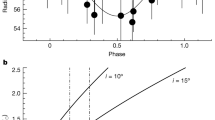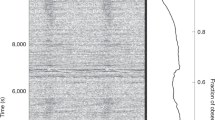Abstract
It is argued here that the recently discovered 6-ms radio pulsar (ref. 1) with orbital period Pb = 120≠4 days, a sin i = (0.92≠0.08) ×1012 cm and e ≈ 0) is the spun up remnant of a formerly heavily accreting (M ≈ 10−8M⊙ yr−1) X-ray source, belonging to a new type of low-mass X-ray binaries. This new type of X-ray binary consists of a critical lobe filling (lower) branch giant star of ≈ 1M⊙ that spills mass to its neutron star companion. Systems of this kind were recently introduced2 to explain the existence of the very bright (Lx ≈ 1038 erg s−1) X-ray sources located in the bulge of M31 and in the bulge of our Galaxy. Such systems will end their lives as wide binary systems (Pb ≳ 100 days), consisting of a≈0.3M⊙ helium white dwarf (the remnant core of the giant) in orbit about a rapidly spinning neutron star. For a suitable combination of magnetic field strength and accretion rate onto the neutron star, it will appear as a millisecond radio pulsar once the giant has lost its envelope and the heavy mass transfer ceases abruptly.
This is a preview of subscription content, access via your institution
Access options
Subscribe to this journal
Receive 51 print issues and online access
$199.00 per year
only $3.90 per issue
Buy this article
- Purchase on Springer Link
- Instant access to full article PDF
Prices may be subject to local taxes which are calculated during checkout
Similar content being viewed by others
References
Boriakoff, V., Buccheri, R. & Fanci, F. IAU Circ. No. 3806 (1983).
Webbink, R. F., Rappaport, S. & Savonije, G.J. Astrophys. J. (in the press).
Zahn, J. P. Astr. Astrophys. 57, 383–394 (1977).
Refsdal, S. & Weigert, A. Astr. Astrophys. 6, 426–440 (1970).
Refsdal, S. & Weigert, A. Astr. Astrophys. 13, 367–373 (1971).
Davidson, K. & Ostriker, J. P. Astrophys. J. 179, 585–598 (1973).
Henrichs, H.F. & van den Heuvel, E. P. J. Nature 303, 213–216 (1983).
Papaloizou, J. & Pringle, J. Mon. Not. R. astr. Soc. 184, 501–508 (1978).
Pacini, F. Nature 216, 567 (1967).
Clark, G., Doxsey, R., Li, F., Jernigan, F. G. & van Paradijs, J. Astrophys. J. Lett. 221, L37–L41 (1978).
Markert, T. H. et al. Astrophys. J. 218, 801–814 (1977).
Eggleton, P. P. Astrophys. J. 268, 368, 369 (1983).
Fabian, A. C., Pringle, J. E., Verbunt, F. & Wade, R. A. Nature 301, 222–223 (1983).
Author information
Authors and Affiliations
Rights and permissions
About this article
Cite this article
Savonije, G. Is the 6-ms binary pulsar the remnant of a bright galactic X-ray source?. Nature 304, 422–423 (1983). https://doi.org/10.1038/304422a0
Received:
Accepted:
Issue Date:
DOI: https://doi.org/10.1038/304422a0
This article is cited by
-
Formation of Double Neutron Stars, Millisecond Pulsars and Double Black Holes
Journal of Astrophysics and Astronomy (2017)
-
Magnetic Fields of Neutron Stars
Journal of Astrophysics and Astronomy (2017)
-
Birth rate of millisecond pulsars
Nature (1995)
-
Scenarios for the formation of binary and millisecond pulsars – A critical assessment
Journal of Astrophysics and Astronomy (1995)
-
Optical detection of the companion of the millisecond pulsar J0437–4715
Nature (1993)
Comments
By submitting a comment you agree to abide by our Terms and Community Guidelines. If you find something abusive or that does not comply with our terms or guidelines please flag it as inappropriate.



